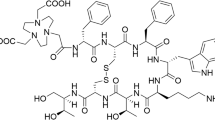Abstract.
Although somatostatin-based peptide receptor imaging (sst-PRI) and peptide receptor radiotherapy (sst-PRRT) of human endocrine tumours and their metastases has become a valuable method, the experience with radiohalogenated sst-directed peptides has so far been disappointing. To extend the broad spectrum of radiohalogens with suitable radionuclide properties for sst-PRI and PRRT, new strategies in ligand development are required. The major drawbacks to be overcome include fast hepatic uptake, high abdominal background activity and low tumour uptake. Recently we introduced radiolabelled glycated octreotides as a new series of sst-binding radiotracers with excellent physicochemical characteristics. In this study we compared [125I]Tyr3-octreotide ([125I]TOC, (1)), [125I]Tyr3-octreotate ([125I]TOCA, (2)) and a carbohydrated octreotide derivative, maltotriose-[125I]Tyr3-octreotate ([125I]Mtr-TOCA, (3)) to evaluate the effect of single C-terminal oxidation and simultaneous N-terminal carbohydration. The biodistribution was compared in nude mice bearing AR42J tumour xenografts. Compared with (1), activity uptake of (2) and (3) at 1 h was decreased in intestine [36% (2), 72% (3)], liver [62% (2), 79% (3)] and kidney [34% (2), 41% (3)], respectively. Blood clearance was fast for all compounds investigated. Using (1) as reference, tumour uptake of (2) and (3) was 3.8- and 4.3-fold higher at 1 h p.i. At 1 h the tumour-to-blood ratio of (3) was 28.2±7.3, and the tumour-to-muscle ratio, 147±48 . Specificity of tumour uptake was demonstrated in AR42J tumour-bearing mice by pretreatment with 0.8 mg TOC/kg 5 min prior to injection of (3). In cells transfected with sst1–sst5, the binding profile of I-Mtr-TOCA revealed a very high affinity and selectivity for sst2. In a first scintigraphic [123I]Mtr-TOCA study of a patient with a carcinoid of the small intestine with known peritoneal carcinomatosis and a solitary liver metastasis, all tumour tissues, including the liver metastasis, were well defined and clearly visible as soon as 30 min p.i. Based on these encouraging findings we conclude that carbohydration is a powerful strategy for the development of new radiolabelled sst-binding peptides and may represent a general method to improve pharmacokinetics of other peptide radioligands. [123I]Mtr-TOCA is a very promising new candidate for sst-directed PRI.
Similar content being viewed by others
Author information
Authors and Affiliations
Additional information
Received 20 March and in revised form 20 September 2001
Electronic Publication
Rights and permissions
About this article
Cite this article
Wester, HJ., Schottelius, M., Scheidhauer, K. et al. Comparison of radioiodinated TOC, TOCA and Mtr-TOCA: the effect of carbohydration on the pharmacokinetics. Eur J Nucl Med 29, 28–38 (2002). https://doi.org/10.1007/s00259-001-0669-1
Published:
Issue Date:
DOI: https://doi.org/10.1007/s00259-001-0669-1




